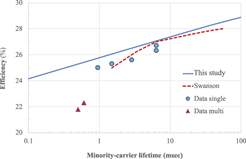Crossref Citations
This article has been cited by the following publications. This list is generated based on data provided by
Crossref.
Yamaguchi, Masafumi
and
Araki, Kenji
2019.
Encyclopedia of Sustainability Science and Technology.
p.
1.
Araki, Kenji
Ota, Yasuyuki
Saiki, Hiromu
Tawa, Hiroki
Nishioka, Kensuke
and
Yamaguchi, Masafumi
2019.
Super-Multi-Junction Solar Cells—Device Configuration with the Potential for More Than 50% Annual Energy Conversion Efficiency (Non-Concentration).
Applied Sciences,
Vol. 9,
Issue. 21,
p.
4598.
Mahto, Rakeshkumar V.
Sharma, Deepak K.
Xavier, Dinosha X.
and
Raghavan, Raksha N.
2020.
Improving performance of photovoltaic panel by reconfigurability in partial shading condition.
Journal of Photonics for Energy,
Vol. 10,
Issue. 04,
p.
1.
Hu, D.
Tan, X. Y.
Sun, L.
Zhang, Y. B.
Tu, Y. T.
and
Yan, W. S.
2021.
Enhanced light absorption of ultrathin crystalline silicon solar cells via the design of front nanostructured silicon nitride.
Journal of Materials Research,
Vol. 36,
Issue. 3,
p.
668.
Yamaguchi, Masafumi
Kamioka, Takefumi
Kojima, Nobuaki
and
Ohshita, Yoshio
2021.
Defect analysis of crystalline Si solar cells by learning radiation-induced defects in Si.
MRS Communications,
Vol. 11,
Issue. 3,
p.
272.
Wang, Wenliang
Jiang, Hongsheng
Li, Linhao
and
Li, Guoqiang
2021.
Two-dimensional group-III nitrides and devices: a critical review.
Reports on Progress in Physics,
Vol. 84,
Issue. 8,
p.
086501.
Yamaguchi, Masafumi
Lee, Kan‐Hua
Araki, Kenji
Kojima, Nobuaki
Okuno, Yasuki
and
Imaizumi, Mitsuru
2021.
Analysis for nonradiative recombination loss and radiation degradation of Si space solar cells.
Progress in Photovoltaics: Research and Applications,
Vol. 29,
Issue. 1,
p.
98.
COŞGUN, Atıl Emre
and
DEMİR, Hasan
2022.
The Experimental Study of Dust Effect on Solar Panel Efficiency.
Politeknik Dergisi,
Vol. 25,
Issue. 4,
p.
1429.
Okamoto, Kazuya
Fujita, Yutaka
Nishigaya, Kosuke
Tanabe, Katsuaki
and
Abbott, Derek
2023.
An all ambient, room temperature–processed solar cell from a bare silicon wafer.
PNAS Nexus,
Vol. 2,
Issue. 3,
Zhang, Xuehua
Zhang, Pei
Zhang, Wei
Chen, Jing
and
Hu, Fangren
2023.
Preparation of UV Curable Optical Adhesive NOA81 Bionic Lotus Leaf Structure Films by Nanoimprint Technique and the Applications on Silicon Solar Cells.
Coatings,
Vol. 13,
Issue. 5,
p.
867.
Yamaguchi, Masafumi
Takamoto, Tatsuya
Juso, Hiroyuki
Nakamura, Kyotaro
Ozaki, Ryo
Masuda, Taizo
Mabuchi, Takashi
Okumura, Kenichi
Kojima, Nobuaki
and
Ohshita, Yoshio
2025.
Approaches for III‐V/Si tandem solar cells and comparative studies on Si tandem solar cells.
Progress in Photovoltaics: Research and Applications,
Vol. 33,
Issue. 1,
p.
116.
